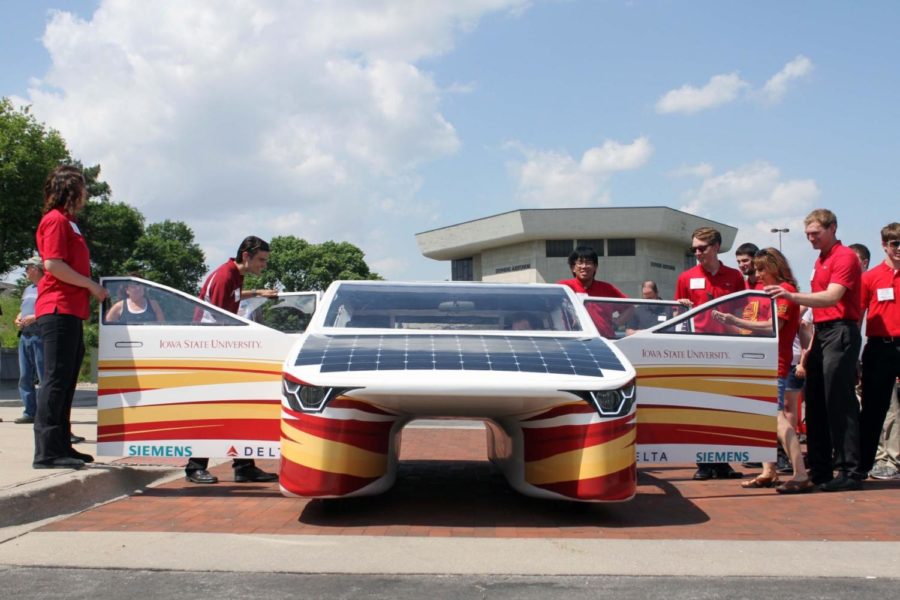Solar car team unveils four-seat solar utility vehicle
June 2, 2017
Iowa State’s student run solar car team, PrISUm, unveiled two years of hard work; the 13th car to come from the team, named Penumbra, is completely different than any car that came before it.
“In the past we’ve done what’s called a Challenger class, that’s a pure racecar,” Daniel Albers, senior in software engineering, said. “With this project we wanted to approach it completely different. Our saying is we want to change the paradigm of transportation.”
The car might be slightly unassuming – mostly white body, with small tires, your usual front and rear windows, even sound system. But those same things are what makes the car so unique – along with the roof of solar tiles.
“The fact that people are sitting in this car, and they’re saying ‘wow, this is a regular car,’ that’s what we want,” Matthew Goode, senior in materials engineering, said. “A one seat car is cool, but if I wanna go on a date, I can’t do that in there, if I want to go get groceries, I can’t do that in [a one seat car].”
Penumbra is an intersection between solar racing vehicles and mainstream SUVs, with stereo system and all. It resembles a small hatchback, and passengers will be able to listen to music, check Facebook and use Google Maps.
“When I joined the team four years ago, there was like 40 guys,” Goode said. “Now we’re 120 students, we have diverse backgrounds, we have people from almost every single department, and now you see a four seat car.”
It’s that four seat car that had a large group gathered outside the Alumni Center on Friday afternoon. Sponsors, family and community members came to view the car, which was propped open so attendants could sit inside. Some companies and sponsors, including Boeing, flew from across the country.
Those sponsors played an important part in the car’s creation and it’s future chance to race in Australia. The production of the car totals $750,000 in materials, machine time and cash, with around two thirds of funding coming from sponsors, according to a release.
“It’s just so surreal to see it here,” Goode said. “We got to use the virtual reality centers on campus, so we sat in the car in virtual reality. But it’s not the same as a finished car, sitting there feeling the steering wheel.
“It’s showing people that its possible.”
Albers focused on software systems, but said the night before the reveal was alongside everyone else working on the final touches. Throughout the two year process, members were able to work outside of their focus area or even major and collaborate on different projects.
“We have Aero E’s working on mechanical engineering things, and we have software engineers working on hardware things, and vice versa, and that’s really cool,” Albers said.
It calls to mind a future where cars aren’t just transportation blocks.
“The coolest thing about a car like this – let’s say you drive it to work,” Goode said. “And then the car finishes charging itself. Then you plug it in to your building, and run your work off your car.”
The potential for cars to gather energy, acting like a battery, could transform parking lots into purpose.
“You would power all of campus just off cars in a parking lot. You really start seeing this future,” Goode said.
From here, the car will go on a 99 county tour around Iowa.
“We’re gonna go to some town, and there’s gonna be some kid there and they’re gonna see this, and they’re gonna say, like, ‘that’s it, that’s what I wanna do,'” Goode said. “And we’re gonna find that next person, or the next fifty, or the next thousand.”
Team PrISUm will send 15 students mid-September to prepare for the Bridgestone World Solar Challenge in Australia. The event starts October 8, 2017, and runs through October 15, 2017.
Teams will begin in the northern city Darwin and race 1864 miles to the southern city of Adelaide. Aside from the allotted stored energy, all cars must obtain 90 percent of their energy from the sun or recover the vehicle’s kinetic energy, according to a release.







